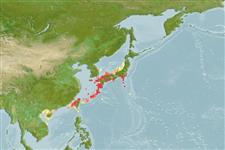Teleostei (teleosts) >
Perciformes/Uranoscopoidei (Sand dwellers) >
Ammodytidae (Sand lances)
Etymology: Ammodytoides: Greek, ammos = sand + Greek, dytes = anyone that likes immersions, diving (Ref. 45335); kimurai: Named for Johnson Kimura.
Eponymy: Johnson Kimura worked at the Ogasawara Fisheries Center on Chichi-jima. [...] (Ref. 128868), visit book page.
More on authors: Ida & Randall.
Environment: milieu / climate zone / depth range / distribution range
Ecology
Marine; demersal; depth range ? - 15 m (Ref. 11668). Temperate
Distribution
Countries | FAO areas | Ecosystems | Occurrences | Point map | Introductions | Faunafri
Northwest Pacific: Ogasawara Islands.
Size / Weight / Age
Maturity: Lm ? range ? - ? cm
Max length : 12.1 cm SL male/unsexed; (Ref. 11668)
Short description
Identification keys | Morphology | Morphometrics
Dorsal spines (total): 0; Dorsal soft rays (total): 48 - 49; Anal spines: 0; Anal soft rays: 23 - 24; Vertebrae: 59 - 61. Body bluish gray dorsally, silvery white laterally and ventrally; dorsal head yellow; dorsal fin with a series of small black spots at outer edge; caudal-fin lobes dusky at the center, the rest whitish . Upper edge of opercle without scales; pelvic fins absent. Body depth 9.7-10 in SL (Ref. 11668).
Life cycle and mating behavior
Maturity | Reproduction | Spawning | Eggs | Fecundity | Larvae
Ida, H. and J.E. Randall, 1993. Ammodytoides kimurai, a new species of sand lance (Ammodytidae) from the Ogasawara Islands. Jap. J. Ichthyol. 40(2):147-151. (Ref. 11668)
IUCN Red List Status (Ref. 130435: Version 2024-1)
Threat to humans
Harmless
Human uses
Tools
Special reports
Download XML
Internet sources
Estimates based on models
Preferred temperature (Ref.
123201): 20.2 - 25.3, mean 22 °C (based on 123 cells).
Phylogenetic diversity index (Ref.
82804): PD
50 = 0.5010 [Uniqueness, from 0.5 = low to 2.0 = high].
Bayesian length-weight: a=0.00324 (0.00140 - 0.00746), b=3.07 (2.88 - 3.26), in cm total length, based on LWR estimates for this (Sub)family-body shape (Ref.
93245).
Trophic level (Ref.
69278): 3.2 ±0.4 se; based on size and trophs of closest relatives
Resilience (Ref.
120179): High, minimum population doubling time less than 15 months (Preliminary K or Fecundity.).
Fishing Vulnerability (Ref.
59153): Low vulnerability (10 of 100).
